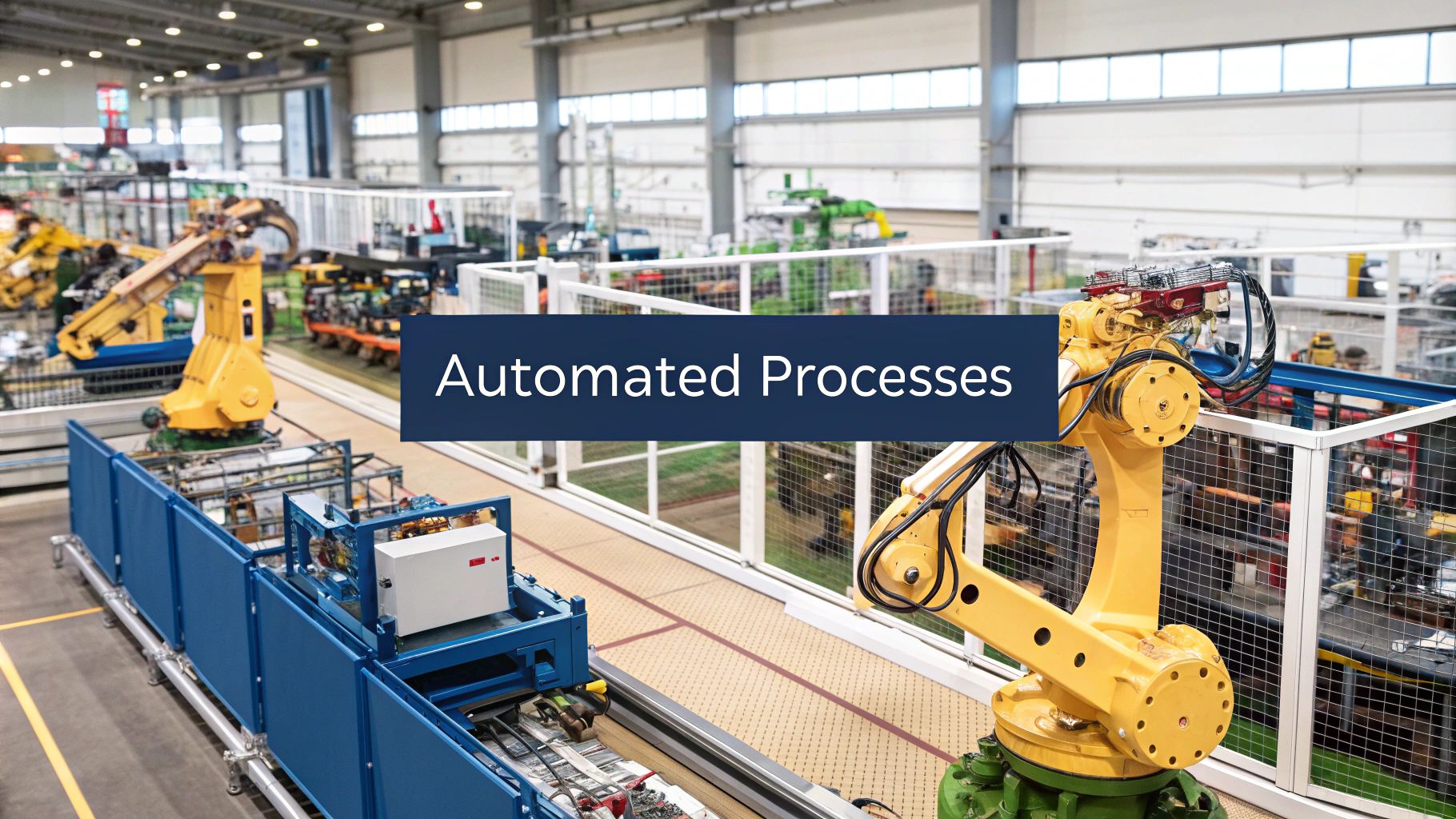Digital Transformation: A Strategic Guide to Business Evolution
Making Sense of Digital Change
When companies adopt new technology, it goes far beyond just buying new software or equipment. It requires rethinking how the entire business works – from daily operations to customer interactions to market competition. This means carefully integrating digital tools across departments while being open to experimenting and learning from setbacks along the way. Getting a clear picture of what this means for your organization is essential before diving into major changes.
Building Blocks for Successful Change
Making digital changes work takes careful planning and a clear strategy. Here are the key elements that help organizations succeed:
-
Put Customers First: Every technology decision should improve things for your customers. For example, if you're getting a new customer service system, make sure it actually makes their experience better. This helps ensure your investments directly boost satisfaction and keep customers coming back.
-
Use Data Wisely: Good data helps you make smarter choices and see if changes are working. Tools like Google Analytics show you how customers use your website and whether marketing campaigns are effective. This lets you adjust your plans based on real results.
-
Stay Flexible: Technology and customer needs keep changing. Being able to adapt quickly and try new approaches helps you keep up. Build a culture where teams feel comfortable testing new ideas.
-
Work Together: Different departments need to communicate well and share knowledge. When sales teams tell product developers what customers want, it leads to better products. Breaking down barriers between teams makes changes more successful.
Common Mistakes to Watch For
While digital changes can bring big benefits, many projects fall short. Here are key pitfalls to avoid:
-
Missing Direction: Without clear goals and ways to measure success, efforts become scattered and ineffective. This wastes resources and makes it hard to get everyone on board.
-
People Resisting Change: When staff push back against new ways of working, it slows everything down. Good training, clear communication about benefits, and addressing concerns help overcome resistance.
-
Forgetting the Human Side: Focusing only on technology while ignoring how it affects employees and customers leads to frustration and lower productivity. Successful changes need proper training and support for everyone involved.
-
Poor Tracking: If you can't measure the impact of changes, it's hard to show their value or know what to adjust. Having the right metrics and reports in place is crucial.
By following these guidelines and actively managing challenges, organizations can make digital changes that last. The process takes careful thought about both technology and people. Tools like Debugbar can help with technical aspects like website development. Remember that digital change is ongoing – keep measuring, learning and improving to stay competitive.
Building Your Technology Foundation
Building strong technology systems requires careful planning and strategic implementation. Like constructing a house, you need to start with the right foundation before adding more complex elements. Random adoption of new tools without proper integration often leads to technical debt and inefficiencies. Taking a methodical approach helps create stable, scalable systems that support your business goals.
Key Components of a Solid Digital Architecture
A well-planned technology setup includes several essential elements working together:
- Cloud Infrastructure: Moving systems to the cloud gives businesses more flexibility to scale up or down as needed. Services like Amazon Web Services (AWS) provide everything from basic file storage to advanced data analysis tools, letting companies pick what works for their specific needs.
- Data Management: Good data practices are crucial for success. This means having clear processes for collecting, storing, and protecting information so teams can access what they need while keeping sensitive data secure.
- Application Modernization: Older software can slow things down. Updating or replacing outdated systems with newer cloud-based options helps everything work better together and run more smoothly.
- AI Integration: Smart use of AI can improve many business areas. For example, using machine learning to better understand customer preferences helps create more effective marketing campaigns.
- Cybersecurity: With more business happening online, strong security is essential. Regular updates, access controls, and data backups help protect against threats and keep operations running.
Choosing the Right Technologies for Your Business
The best technology choices depend on what your business needs to accomplish. A retail company might focus on e-commerce and customer tracking systems, while a manufacturer may need factory automation and inventory management tools. Tools like Debugbar can help check how well your website performs and spot areas to improve.
Balancing Innovation with Stability
When adding new technology, it's important to move at the right pace. Making changes too quickly can disrupt your business and create unexpected problems. Starting small with test projects lets you work out issues before rolling out bigger changes. Regular check-ins help ensure your systems keep supporting your goals as the business grows. Think of it as an ongoing process – you're building and improving your technology foundation over time rather than trying to do everything at once.
Creating a Digital-First Culture
While technology forms the foundation for modernizing business operations, the human element remains essential for success. Companies need their people to genuinely embrace and effectively use digital tools, not just comply with directives from above. When employees understand how technology makes their work easier and more impactful, adoption happens naturally. Recent data shows that despite $2.5 trillion in technology spending in 2024, many projects fall short simply because organizations overlook the importance of cultural change.
Building Organizational Buy-In
Getting everyone on board requires open communication about what's changing and why it matters. Leaders need to clearly explain the benefits of new systems – like how a CRM helps sales teams better serve customers rather than just track their activities. Including employees in planning discussions and listening to their input creates shared ownership in the process. When people feel heard and understand their role in making improvements successful, they're more likely to actively participate in the changes ahead.
Developing Digital Capabilities
Success requires going beyond basic computer skills to build expertise in key areas like data analysis, digital marketing, and cybersecurity. Companies should invest in ongoing training and create opportunities for employees to learn from each other. Pairing tech-savvy team members with those still building their skills helps spread knowledge naturally. Resources like Debugbar give teams easy access to current best practices and trends they can apply in their daily work.
Fostering an Innovation Mindset
Adapting to change works best when companies encourage testing new approaches and learning from both successes and setbacks. Setting up innovation labs or hackathons gives teams space to explore creative solutions without pressure. But experimental projects should connect clearly to business goals – innovation works best when solving real problems, not just testing technology for its own sake. This balanced approach helps organizations steadily improve their capabilities while staying focused on practical results. Regular refinements based on what works keeps companies moving forward as technology continues to evolve.
Creating an Outstanding Customer Experience
Better customer experiences are the ultimate goal of any technology and culture updates in your organization. Every point where customers interact with your business matters – from their first contact to ongoing support. Businesses that put customers first and create excellent experiences see real results, with top performers seeing 80% better outcomes than companies that lag behind in this area.
Mapping Important Digital Contact Points
Start by looking at where your customers connect with your business online. Your website, mobile app, social media accounts, emails, and chat support are all key places to focus on. Watch how customers use these different channels and find out what works well and what frustrates them. Tools like Hotjar can show you exactly how people move through your website, giving you clear insights into their behavior. Understanding these patterns helps you make smart improvements to how customers experience your brand.
Making the Customer Journey Better Step by Step
After you know which contact points matter most, focus your efforts where they'll have the biggest impact. This could mean making your website easier to use, sending more personalized emails, or adding chat support that responds right away. Keep track of how well these changes work by measuring things like customer satisfaction scores, Net Promoter Score (NPS), and how many customers stick around. Looking at customer feedback through surveys and reviews shows you what needs work and helps guide product improvements.
Finding the Right Mix of Technology and Personal Service
While technology makes many things faster and easier, customers still want to talk to real people, especially for complex issues or personal help. Smart businesses use automation for routine tasks, which frees up their staff to build real connections with customers and provide caring, thoughtful service. Debugbar provides helpful guidance on blending technology with genuine human interaction. This approach helps companies work more efficiently while building stronger customer relationships and loyalty.
Scaling Digital Operations
Moving from small pilot projects to full company-wide digital changes is like growing a garden – it needs careful planning, attention, and the right conditions to thrive. Success comes from looking beyond the excitement of early wins to build something that lasts.
Planning for Scalability from the Start
Many companies make the mistake of not thinking about growth when they first start digital projects. This often leads to problems later when systems that worked well for small teams struggle with bigger demands. Take a retail store testing a new online ordering system – if it's not built to handle orders from multiple locations, expanding it across all stores becomes a huge headache. That's why planning for growth from day one is so important. Tools like Debugbar can help test how well web applications perform as they grow.
Managing Resources Effectively
As digital projects expand, they need more people and money to succeed. Getting this right means having skilled team members and enough budget to support growth. Smart companies look for ways to use what they already have – like existing computers or training current staff for new roles. For example, when rolling out a new customer service system, it often makes more sense to train existing representatives than hire an entirely new team.
Mitigating Risks and Ensuring Stability
Bigger digital systems face more security risks and technical challenges. When more parts of your business depend on technology, problems can have bigger impacts. This makes having good safety measures essential. Regular security checks and data backups protect against breaches and system failures. Changes need to happen carefully too – rolling out updates in phases and watching closely for problems helps avoid disrupting daily work.
Optimizing for Performance and Efficiency
Growing isn't just about getting bigger – it's about getting better. Small inefficiencies can become big problems as systems expand. Setting clear goals and tracking progress helps identify where improvements are needed. For instance, measuring how long customers wait or how quickly orders are filled shows where automated tools or better processes could help. By constantly looking for ways to work smarter, companies can get the most value from their digital investments and stay ahead of competitors.
Measuring Transformation Success
Getting real value from technology improvements requires careful measurement. Simply tracking basic metrics like website traffic isn't enough – companies need to understand how their tech investments drive actual business results like leads, sales and revenue growth. This helps prove the worth of tech projects and secure support for future improvements.
Developing Meaningful KPIs
Good measurement starts by picking the right metrics that connect directly to your business goals. You'll want a mix of hard numbers and feedback about people's experiences.
- Measurable Data Points: These show clear progress through numbers:
- Conversion Rate: How many website visitors take action like making a purchase
- Customer Acquisition Cost: What you spend to get each new customer through online channels
- Revenue Growth: Extra income that comes from your tech improvements
- Experience Feedback: This reveals how people feel about the changes:
- Customer Surveys: Direct input about their experience using your digital tools
- Employee Interviews: Staff feedback on how new tools affect their work
- Social Media Analysis: What people say about your brand online
Tracking Progress and Adjusting Course
Once you pick your metrics, you need a way to track them regularly. Many companies use dashboards and project tools to stay on top of performance. Debugbar helps monitor how well web applications run and spots areas to improve. By checking the numbers often, you can catch problems early and make smart adjustments. For example, if lots of people leave a certain webpage quickly, you can figure out why and fix it.
Showing Value to Decision Makers
Good measurement isn't just for the tech team – you need to show business leaders how these projects help the company succeed. This means creating clear reports and presentations that connect tech improvements to business results. Share real examples of how the changes helped customers and employees do things better or faster. Tell the story of how tech investments lead to better service and stronger financial results.
By measuring what matters and sharing the results effectively, companies can make sure their tech improvements deliver real, lasting value that helps the business grow.
Want to track and improve your web applications? See how Debugbar can help you succeed. Visit Debugbar today!




Comments
Leave a comment